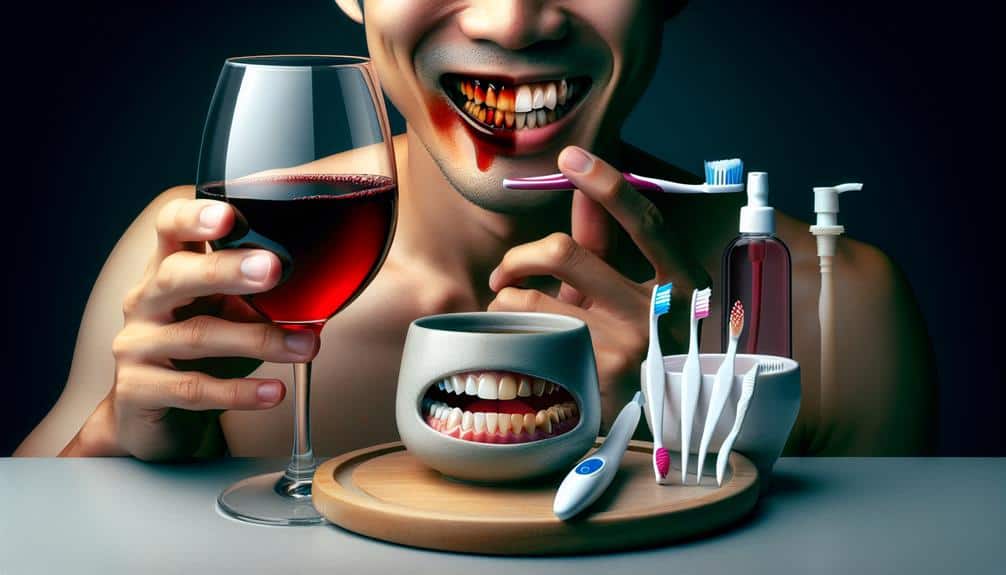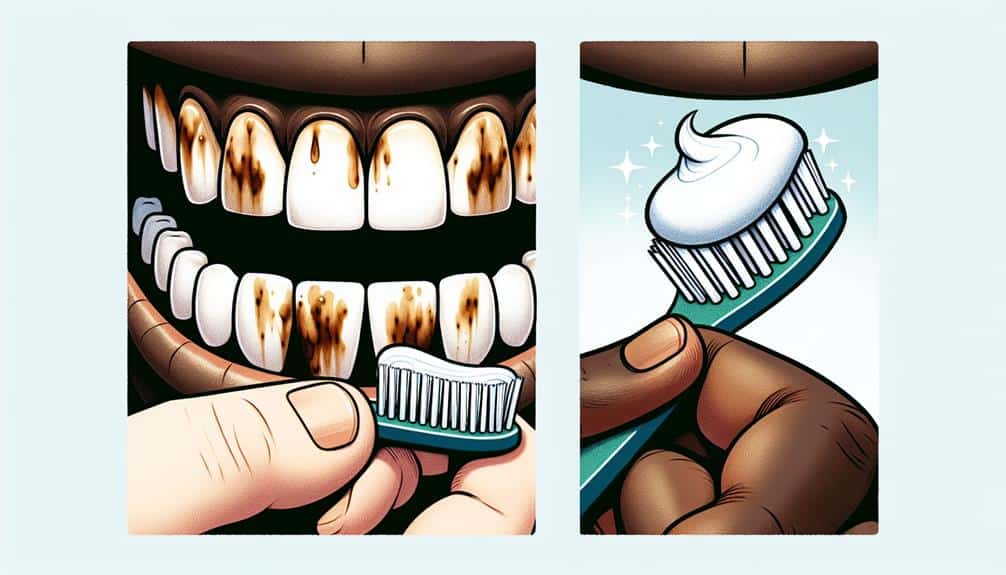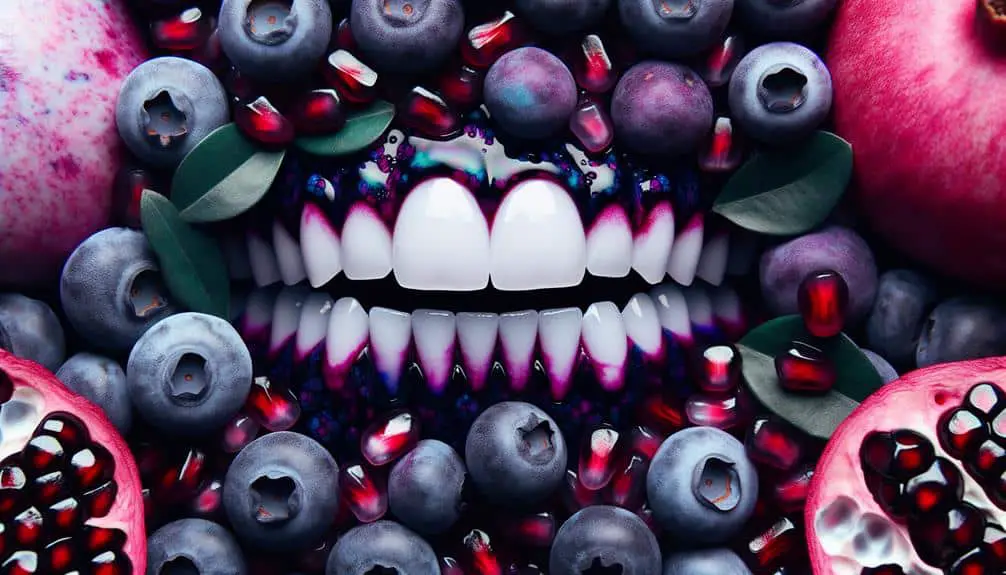To prevent soy sauce teeth discoloration, start by choosing a whitening toothpaste with hydrogen peroxide or baking soda. Make sure to practice good dental hygiene by brushing your teeth at least twice a day, flossing regularly, and using mouthwash to rinse away residual soy sauce. Additionally, consider scheduling routine dental cleanings and limiting your consumption of heavily pigmented foods. By being proactive in your dental care routine, you can maintain a bright and healthy smile.
Key Points
- Brush teeth after consuming soy sauce to prevent pigments from adhering.
- Use whitening toothpaste with baking soda or hydrogen peroxide for stain removal.
- Rinse mouth with water after eating soy sauce to reduce pigments on teeth.
- Schedule regular dental cleanings to remove any accumulated stains.
- Limit consumption of heavily pigmented foods to prevent teeth discoloration.
Understanding Soy Sauce Teeth Stains
To understand the cause of soy sauce teeth stains, consider the interaction between tooth enamel and pigmented compounds in the soy sauce. Soy sauce contains dark pigments that can adhere to the surface of your teeth, leading to discoloration over time. These pigments can penetrate the porous enamel, making it challenging to remove them through regular brushing alone. Understanding this process is vital in implementing effective prevention methods and proper dental care to maintain a healthy smile.
Preventing soy sauce teeth stains starts with good oral hygiene practices. Regular brushing and flossing help remove food particles and plaque that can attract and hold onto pigmented compounds from soy sauce. Additionally, scheduling routine dental cleanings can aid in the removal of stubborn stains and prevent them from becoming deeply embedded in the enamel. Maintaining a balanced diet and limiting the consumption of heavily pigmented foods like soy sauce can also contribute to minimizing teeth discoloration. By being proactive in your dental care routine, you can effectively combat soy sauce teeth stains and preserve the natural whiteness of your teeth.
Tips to Avoid Soy Sauce Discoloration
Understanding how soy sauce can lead to teeth discoloration, it's important to implement practical tips to avoid this issue and maintain a brighter smile. When it comes to preventing soy sauce teeth discoloration, choosing the right toothpaste can make a significant difference. Opt for whitening toothpaste that contains ingredients like hydrogen peroxide or baking soda, as these can help remove surface stains and prevent new ones from forming.
Additionally, practicing good dental hygiene is vital in avoiding teeth discoloration caused by soy sauce. Make sure to brush your teeth at least twice a day, floss regularly, and consider using mouthwash to rinse away any residual soy sauce that may linger on your teeth.
Incorporating these tips into your daily dental routine can go a long way in preserving the whiteness of your teeth and preventing soy sauce discoloration. Remember, proactive care and consistent oral hygiene practices are key to maintaining a healthy, bright smile free from the stains that soy sauce can cause.
Foods That Cause Teeth Discoloration
Certain foods, such as coffee, tea, and red wine, are known to cause teeth discoloration over time. Coffee stains are a common culprit due to their dark pigments that can easily adhere to the enamel of your teeth, leading to a yellowish or brownish tint. Tea, especially black tea, contains tannins that promote staining, making it another beverage to watch out for.
Red wine discoloration is another concern as the deep hues in red wine can seep into the microscopic cracks in your enamel, causing unsightly stains. Additionally, acidic foods like citrus fruits and tomato-based sauces can erode tooth enamel, making it easier for stains from other foods to set in. Sugary treats and beverages can also contribute to discoloration by feeding bacteria that produce acid, leading to enamel erosion and staining.
Being mindful of your consumption of these foods can help you maintain a brighter smile.
Protective Measures for Whiter Teeth
For whiter teeth, implementing simple yet effective protective measures can help maintain a brighter smile and prevent discoloration. Consistent care and attention to oral hygiene are key factors in achieving and preserving a radiant smile. Here are three essential protective measures you can incorporate into your daily routine:
- Teeth Whitening Toothpaste: Opt for a toothpaste specifically formulated for teeth whitening. These toothpaste varieties often contain gentle abrasives or polishing agents that help remove surface stains, resulting in a brighter smile over time.
- Regular Dental Check-ups: Schedule routine dental check-ups to monitor your oral health and address any concerns promptly. Professional cleanings and treatments can help prevent discoloration and maintain the whiteness of your teeth.
- Healthy Dietary Choices: Consuming a balanced diet rich in fruits and vegetables can contribute to overall oral health and whiter teeth. Avoiding foods and beverages that are known to cause teeth discoloration, such as coffee or red wine, can also help preserve the brightness of your smile.
Removing Soy Sauce Stains From Teeth
To maintain a bright smile free from soy sauce stains, it's important to understand effective methods for removing these stubborn discolorations from your teeth. When dealing with soy sauce stains, there are several teeth whitening options and stain removal techniques that can help restore the natural color of your teeth.
One approach is to brush your teeth immediately after consuming soy sauce to prevent the staining agents from setting in. Using a whitening toothpaste containing mild abrasives can also be beneficial in removing surface stains. Additionally, consider using baking soda as a gentle abrasive to scrub away stubborn soy sauce discolorations.
Another effective method is oil pulling with coconut oil, which can help lift stains and promote overall oral health. For more persistent stains, professional dental cleanings and whitening treatments may be necessary. By incorporating these teeth whitening options and stain removal techniques into your oral care routine, you can effectively combat soy sauce stains and maintain a bright, stain-free smile.
Frequently Asked Questions
Can Drinking Water While Consuming Soy Sauce Help Prevent Teeth Staining?
When enjoying soy sauce, remember, water is your ally against teeth staining. Sip water while eating to rinse away the sauce and protect your smile. Proper brushing technique and good dental hygiene support stain prevention efforts.
Are There Any Specific Toothpastes or Mouthwashes That Are Effective in Removing Soy Sauce Stains From Teeth?
To effectively combat soy sauce stains on your teeth, consider using whitening toothpaste with baking soda or activated charcoal. Mouthwashes containing hydrogen peroxide can also help. Proper brushing techniques and regular flossing are essential for maintaining oral hygiene.
How Long Does It Take for Soy Sauce Stains to Set on Teeth After Consumption?
When soy sauce stains set on teeth post-consumption depends on varying factors like oral health and enamel strength. To prevent quick staining, maintain diligent dental hygiene. Regular brushing, flossing, and rinsing can aid in swift stain removal.
Will Using a Straw When Drinking Soy Sauce Beverages Prevent Teeth Discoloration?
When drinking soy sauce beverages, using a straw can be effective in preventing teeth discoloration. Other prevention techniques include rinsing your mouth with water after consumption, brushing your teeth regularly, and using whitening toothpaste to combat stains.
Are There Any Home Remedies or Natural Methods to Prevent or Remove Soy Sauce Stains From Teeth?
To prevent or remove soy sauce stains on teeth, try natural remedies like baking soda or activated charcoal. Adopting dietary modifications can also help maintain tooth health. Consistent oral hygiene and regular dental check-ups are key.




